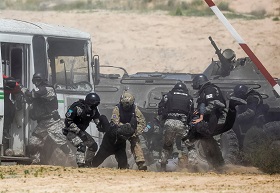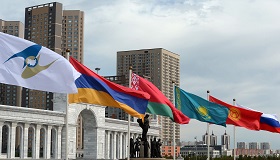Central Asia is a region with very uneven social and economic dynamics. It is rapidly breaking down into areas with different quality of life, economic growth, environmental health, quality of social services and infrastructure access. This makes it hard to find common socio-economic problems that would be of equal concern to those living in big cities and small villages.
At the same time, Central Asia is riddled with many paradoxes that pose serious challenges to the region’s socio-economic development, so it is worth examining the situation as an interplay of contradictory processes.
First, the Central Asian population is still growing, and high unemployment is compounded by a lack of skilled workforce and low quality of human capital. In addition, many parts of Central Asia suffer from an acute lack of other kinds of infrastructure, such as power and domestic gas supply. Systematic power supply restrictions are the norm in many areas of Uzbekistan, Tajikistan and Kyrgyzstan, and challenges related to grid access are among the most critical barriers to developing large-scale industrial production. Additionally, there is a severe shortage of skilled professionals in the healthcare, education, industry, transport and utility sectors. This is why Central Asian economies annually attract several dozen thousand foreign blue- and white-collar workers from China, Turkey, Russia, India and other countries for implementing new industrial and construction projects.
To summarise, resolving the paradoxes outlined above will be the strategic goal for all Central Asian countries over the coming 15 to 20 years. This is precisely the key to the “big transformation" of the region that is currently underway.
Central Asia is a region with very uneven social and economic dynamics. It is rapidly breaking down into areas with different quality of life, economic growth, environmental health, quality of social services and infrastructure access. This makes it hard to find common socio-economic problems that would be of equal concern to those living in big cities and small villages.
At the same time, Central Asia is riddled with many paradoxes that pose serious challenges to the region’s socio-economic development, so it is worth examining the situation as an interplay of contradictory processes.
First, the Central Asian population is still growing, and high unemployment is compounded by a lack of skilled workforce and low quality of human capital. Despite significant migration outflow over the last 30 years, the population of the region has increased by 47 per cent or more than 23 million people. Considering the youthful population (the average age in Central Asia, as of 2015, ranged from 22 in Tajikistan to 29 in Kazakhstan) and the large number of children in families (for example, in Tajikistan the average number of children per woman is 3.8), it is evident that the growth will continue, albeit at a slower pace.
Unemployment continues to be an issue in all the countries of the region, affecting young people the most. According to official statistics, the unemployment rate ranges from 2.3 per cent in Tajikistan to 9.3 per cent in Uzbekistan, while the total number of jobless tops two million.
Experts say the problem is much bigger, though, since a large share of unemployed people is unregistered, being classified as seasonal workers or self-employed, as well as migrating to find work abroad. Hundreds of thousands in Central Asia do not register as unemployed for several reasons: the complicated and lengthy bureaucratic procedure, a lack of legal literacy and the very low labour productivity.
The share of unemployment is estimated to be 10–15 per cent in cities and 40–60 per cent in rural areas. This makes mardikor bazaars, or day labourer markets, a universal phenomenon in labour-surplus parts of Central Asia and more than five million people are pushed to travel abroad to find work.
At the same time, there is a severe shortage of skilled professionals in the healthcare, education, industry, transport and utility sectors. This is why Central Asian economies annually attract several dozen thousand foreign blue- and white-collar workers from China, Turkey, Russia, India and other countries for implementing new industrial and construction projects.
One of the main reasons for this paradox is most people’s persistently low standard of education and skills in the region. The share of the able-bodied population with secondary and higher vocational education in Central Asia is significantly lower than in Russia or Europe. National education systems cannot provide the region’s economies with the required amount of adequately skilled workforce. A high level of corruption, low teacher qualifications and weak infrastructure do not allow for training students properly.
This is why a large proportion of young people in Central Asia study abroad, in Europe, North America, China and other East Asian countries. Russia has a strong position as the leading supplier of skills for the region, with it currently providing education to more than 100,000 people from Central Asia, which is over a half all the international students in Russia. Even though half of these stay in Russia to work after graduating, people with Russian degrees play a crucial role in Central Asia’s economic development. I am confident that their numbers should and will grow.
Second, Central Asia is characterised by rapid economic growth, which has been accompanied by a significant increase in the quality of life and success in combatting poverty in the last 20 years. At the same time, the poorly diversified local economies are dependent on the external economic situation. The small domestic market, weakened by a wave of currency devaluations in 2014–2019, cannot produce the required demand and new projects are entirely dependent on foreign companies in terms of technology.
In the last 15 years, the Central Asian economies have been growing faster than those of many of their neighbours, such as the EU, Russia, Iran and Turkey. The poorest country of the region, Tajikistan, has seen a drop in poverty from 73 per cent in 2003 to 31 in 2015. Significant changes have also been observed in GDP composition, with a significant fall in the share of agriculture. Yet the region’s economies are still dependent either on mineral exports (Kazakhstan, Turkmenistan and Uzbekistan) or on workforce exports (Tajikistan and Kyrgyzstan).
Considering the small middle class – its absolute size is difficult to ascertain, but it includes about 30 per cent of the population (from 35 per cent in Kazakhstan to 5 per cent in Tajikistan) – and the small domestic market, the countries of the region are bound to go down the path of export-orientated economic development. Even so, the low level of localisation of high-tech manufacturing, the lack of skilled workers, and the dependence on imported equipment and technology in the key economic sectors all create obstacles to developing value-added exports. Despite the obvious successes of individual sectors, such as light industry (textiles, clothing and food), non-ferrous metals, construction materials and transport, Central Asian countries are increasingly reaching the objective limits of their growth.
A colossal shadow economy characterises the region. For example, according to Minister of Employment and Labour Relations of the Republic of Uzbekistan Sherzod Qudbiyev, only 40 per cent of the country’s economically active population is officially employed, while the rest are engaged in the shadow sector. Widespread corruption and the active role of the state in the economy hinder the development of private business. Most big business owners either have connections to the state or accumulated their capital abroad.
Third, being located in the heart of Eurasia, the region has a unique geographical advantage. Still, its transit potential is poorly realised owing to underdeveloped infrastructure, customs and technical restrictions, as well as a high level of corruption. For example, railway freight transit across Kazakhstan in 2018 only slightly exceeded 17 million tonnes, which is a fraction of the volume carried along the Trans-Siberian Railway.
Underdevelopment of the infrastructure is the result of a variety of factors. For instance, Kazakhstan was the only country formed after the fall of the USSR that had a relatively well-developed railway network connecting all its regions. In other Central Asian states, transport between regions relied on transit through neighbouring countries. In Uzbekistan, the only railway connection from Tashkent to Termez was through Turkmenistan.
In the almost 30 years since the collapse of the USSR, Central Asian countries have built several thousand kilometres of domestic and international railway lines. Yet serious problems remain. Turkmenistan completed the consolidation of its national railway network into a single system in 2006, Uzbekistan only did so in 2018, while Tajikistan and Kyrgyzstan still do not have a fully-fledged national railway network. Road transit capacity also remains an open issue in the region.
In addition to the underdeveloped transport network, many parts of Central Asia suffer from an acute lack of other kinds of infrastructure, such as power and domestic gas supply. Systematic power supply restrictions are the norm in many areas of Uzbekistan, Tajikistan and Kyrgyzstan, and challenges related to grid access are among the most critical barriers to developing large-scale industrial production.
The housing and utilities infrastructure is also heavily stressed in Central Asian countries. For instance, according to the World Bank, central heating and small boilers are available to only 8 per cent of the population in Tajikistan, with most of those 8 per cent living in the capital Dushanbe. Heating services are also characterised by poor service quality and low supply reliability. As a result of the declining reliability of heat supply, radiators and the domestic heating infrastructure have been dismantled in almost 80 per cent of urban buildings previously connected to the centralised heating system. The severe energy crisis in the winter of 2007–2008 in Tajikistan and the accident at Bishkek Thermal Power Plant, Kyrgyzstan, in January 2018 highlight the fact that the utility gap remains.
To summarise, resolving the paradoxes outlined above will be the strategic goal for all Central Asian countries over the coming 15 to 20 years. This is precisely the key to the “big transformation" of the region that is currently underway.







